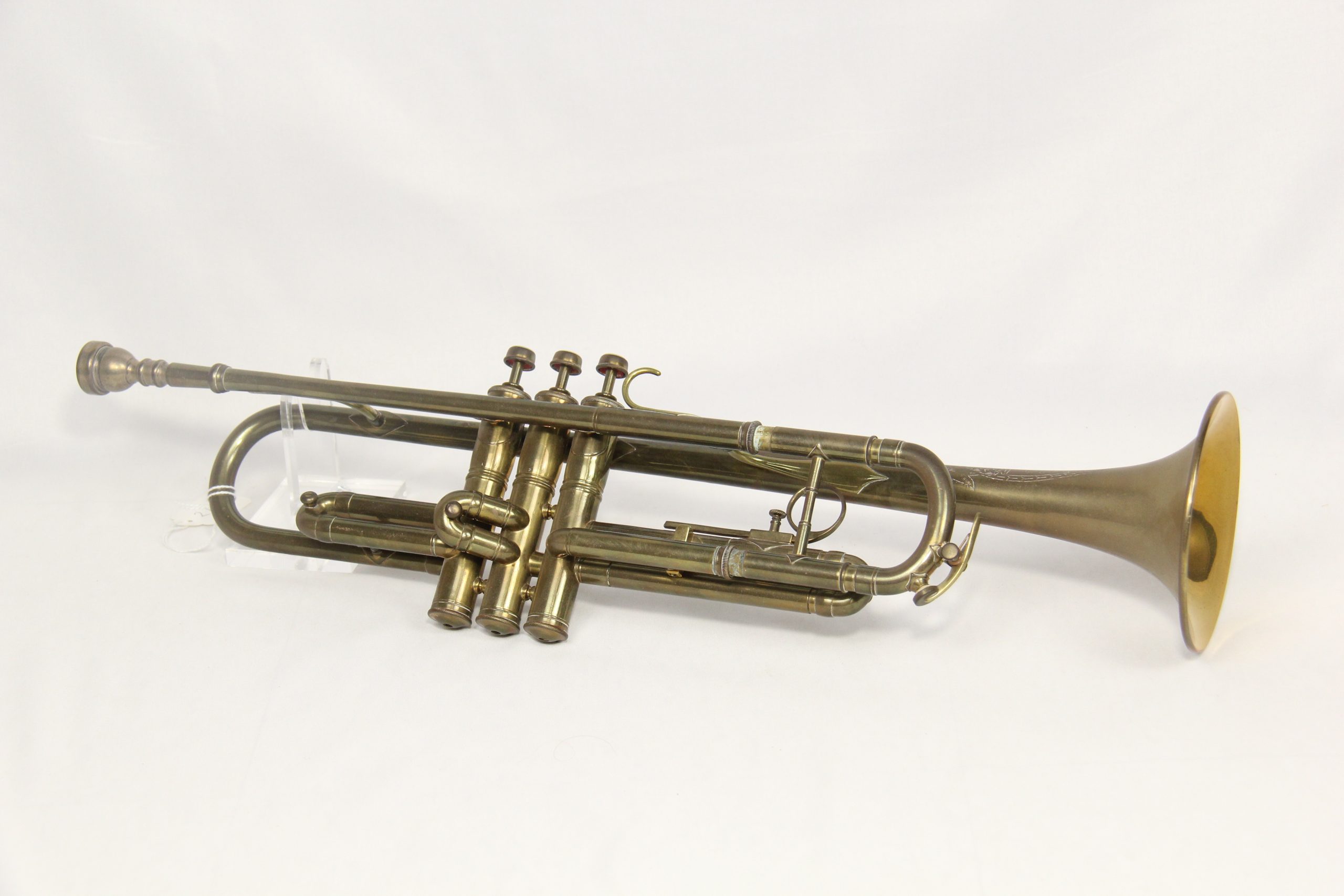B-flat Trumpet with Slide
Details
- Origin: Boston, MA
- Date: 1922
- Maker: The Vega Company
- Collection: E 263
Description
Valve trumpet. 3 périnet valves, at right of bell tube. Material: Brass, .58mm thick at bell, silver, felt, pad, mother of pearl keys. Tuning slide on first bend; A-slide inside of tuning slide, closed with knurled closing nut; water key on first bend; left hand finger ring in screw-closing mount on 3rd valve slide.
Engraved on bell: “Chas. E. George / Model / (Trade mark) / Vega / Standard / Made by / The Vega Company / 755. Columbus Ave / Boston”. Engraved on back 2nd valve: “Pat. July 1910 / Standard / (in star) Vega / Boston” “Union / (in shield) [illegible] / Label”.
Contains serial number: 20367, back 2nd valve.
This instrument is a very rare “Charles E. George” model made by Vega. It was bought in 1922 for $114, at that time an expensive trumpet.
Charles E. Vega was a famous trumpet player and band leader in Boston around the turn of the 20th century and later. He created a patent in July 1910 which is used in many of his trumpets. Charles E. George apparently had instruments made to his specifications and with his name before he worked for the Vega Company. The company had undergone many changes, previously operating under names including Quinby Brothers, Hall & Quinby, Hall Quinby Wright Company, and others. It had been founded in 1861 by David Hall, a band leader, bugle player and instrument maker. The name Wright came from E.G. Wright whose E.G Wright and Company merged with other investors to create the Boston Musical Instrument Manufactury in 1869. Wright was briefly a partner in the company between 1870 and his death. In 1909, The Vega Company, recognized principally for their banjos, bought the Standard Band Instrument Company of Boston, and incorporated their line of horns. Vega built brass instruments under the Vega and Standard names well into the 20th century.

The cornet and Bb trumpets are the most commonly played trumpets today and the first choices for beginning trumpeters. There was a steady increase in the use of the Bb trumpet through the first decades of the twentieth century, initially in orchestras of all kinds and later for jazz, dance band, swing and bebop.
François Périnet invented the modern version of the piston valve in the late 1930s. As valves were added, tubing evolved to have varying lengths bent to different degrees (called crooks and shanks). These were added to the body of the trumpet. The length of shape of the tubes determines the quality and range of sounds produced by the air moving through them. The F and G trumpets, the earliest examples of valve trumpets, were far larger and more difficult to handle than modern-day trumpets. They were groundbreaking at the time of their 19th century creation because they allowed trumpeters to play a wider range of notes and songs in various key signatures.
Sources
- HOWELL, JOCELYN, and ARNOLD MYERS. “Hawkes & Son, Instrument Makers.” The Galpin Society Journal 68 (2015): 121–49. http://www.jstor.org/stable/44083258.
- Walker, David. “A Brief History of the Trumpet: The Origins and Evolution.” Hello Music Theory: Learn Music Theory Online, June 3, 2022. https://hellomusictheory.com/learn/history-of-the-trumpet/.
- Turner, Tom. “History of Vega and Standard Cornets,” https://trumpetboards.com/category/42/trumpetmaster-archives.
- Wikimedia Commons contributors, “File:1919 VegaCo trumpet JacobsBandMonthly Boston June.png,” Wikimedia Commons, the free media repository, https://commons.wikimedia.org/w/index.php?title=File:1919_VegaCo_trumpet_JacobsBandMonthly_Boston_June.png&oldid=427711031 (accessed June 17, 2022).







